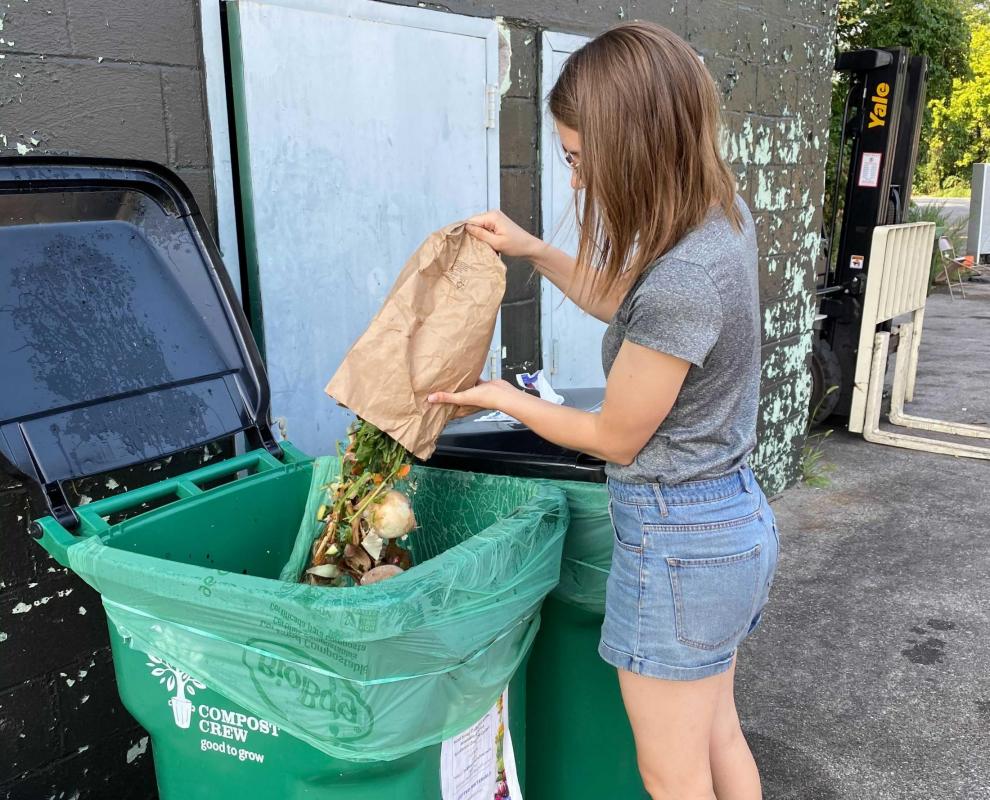
Just before 9 a.m. on a midsummer Friday, April Welch sets off from her Remington home, carrying a brown paper bag full of food scraps to the city’s Citizen Drop-Off Center on Sisson Street.
Once she arrives, she spots a large green trash bin behind the gate, opens the lid, and spills a colorful blend of apple cores, mango bits, banana peels, and green leaves into a high pile of organic waste.
“It’s really easy,” says Welch, concluding her second compost delivery. Her first, almost three weeks ago, was just days after Baltimore kicked off its first city-wide food waste pilot drop-off program—which aims to promote a sustainable, zero-waste future by gathering food scraps at five residential collection sites.
Now, almost a month in, citizens are taking advantage of the project as a convenient (and free) way to compost. It’s a good sign for city officials, who hope that the initiative will change how Baltimoreans think about their food waste overall.
“This is the first time we’ve done something like this on city-owned property,” says Kristyn Oldendorf, who leads the program at the city’s Department of Public Works. “Anything we can do to increase composting and reduce waste is really important.”
According to a recent tally of residential trash conducted by the city, food scraps make up roughly 25 percent of the city’s waste stream. If they’re not composted, most of these scraps are incinerated or go straight to a landfill. “It takes so much to create food,” Oldendorf adds, “Just throwing the material away is not the best use of it.”
The inspiration for the pilot project was sparked by the Baltimore Office of Sustainability’s Food Matters Program, which offers two food scrap drop-off sites at the 32nd Street Farmers Market and the Baltimore Farmers Market and Bazaar under the JFX. After observing auspicious participation at these sites, and obtaining extra funding from Natural Resources Defense Council, the city decided to expand its food waste collection to all five of its citizen drop-off centers. At these locations, which are typically used to collect single-stream recycling and large bulk items, residents can now dispose of food scraps six days a week at varying hours.
The pilot program will run about three to four months, Oldendorf says. And depending on people’s participation, the city will then decide whether to keep the program for the long run, or even expand.
Through the data collected throughout the program, city officials are also hoping to have a better grasp of which drop-off site is the most popular (the Sisson Street Drop-Off Center is in the lead thus far), the volume of the food waste at each site, and regular drop-off routines to further optimize the waste pick-up and composting resources.
So far, the project seems to be off to a good start. As of last week, the city has collected just shy of 500 pounds of food scraps from the five sites. Once per week, Compost Crew, a Maryland-based organic waste hauler, transports the collected scraps to the Prince George’s County Organics Composting Facility. There, the leftover bits from people’s kitchens decompose with the help of a host of microorganisms, breaking down into dark, nutrient-rich material that can be put back to the soil.
But there are still some hurdles to navigate. For starters, the DPW is working on how to educate residents on minimizing contamination—such as nylon, paper products, and plastic bags—in the composting stream. The city currently accepts fruits, vegetables, eggshells, gourds, grains and bread, pasta, coffee grounds, and tea bags. It does not allow plastic bags, dairy, meat, oils, paper products, produce stickers, compostable bags, or tableware.
It’s worth noting that even before the pilot program, many Baltimoreans had already begun composting their food waste—through grassroot composting collectives, community gardens, or even their own backyards. And Oldendorf makes it clear that the city’s drop-off program is not meant to compete with other community-based programs. Instead, she hopes the initiatives can work together, providing what she calls “a menu of options” for residents to reduce waste.
“We work closely with a lot of local composters,” she adds. “The goal here really is to promote residents to think about their food waste.”
Nora Frankel is another Remington resident who recently made her first trip to drop off her saved food scraps.
“I was excited,” says Frankel. “As soon as I heard about the program, I immediately bought a compost bin.”
Walking from the southern edge of Remington, the trip for Frankel is just about 10 minutes one way. And although it is her first time going to the site, she immediately recognizes the waste bins, opens her composting container, and unleashes a parade of coffee grounds and vegetable scraps.
Throwing food away breaks her heart, she says, but she also knows the bits and pieces she just let go of will eventually make their way back to earth, nourishing more lives in the soil.
“Compositing,” she says, “gives food a complete life cycle.”
